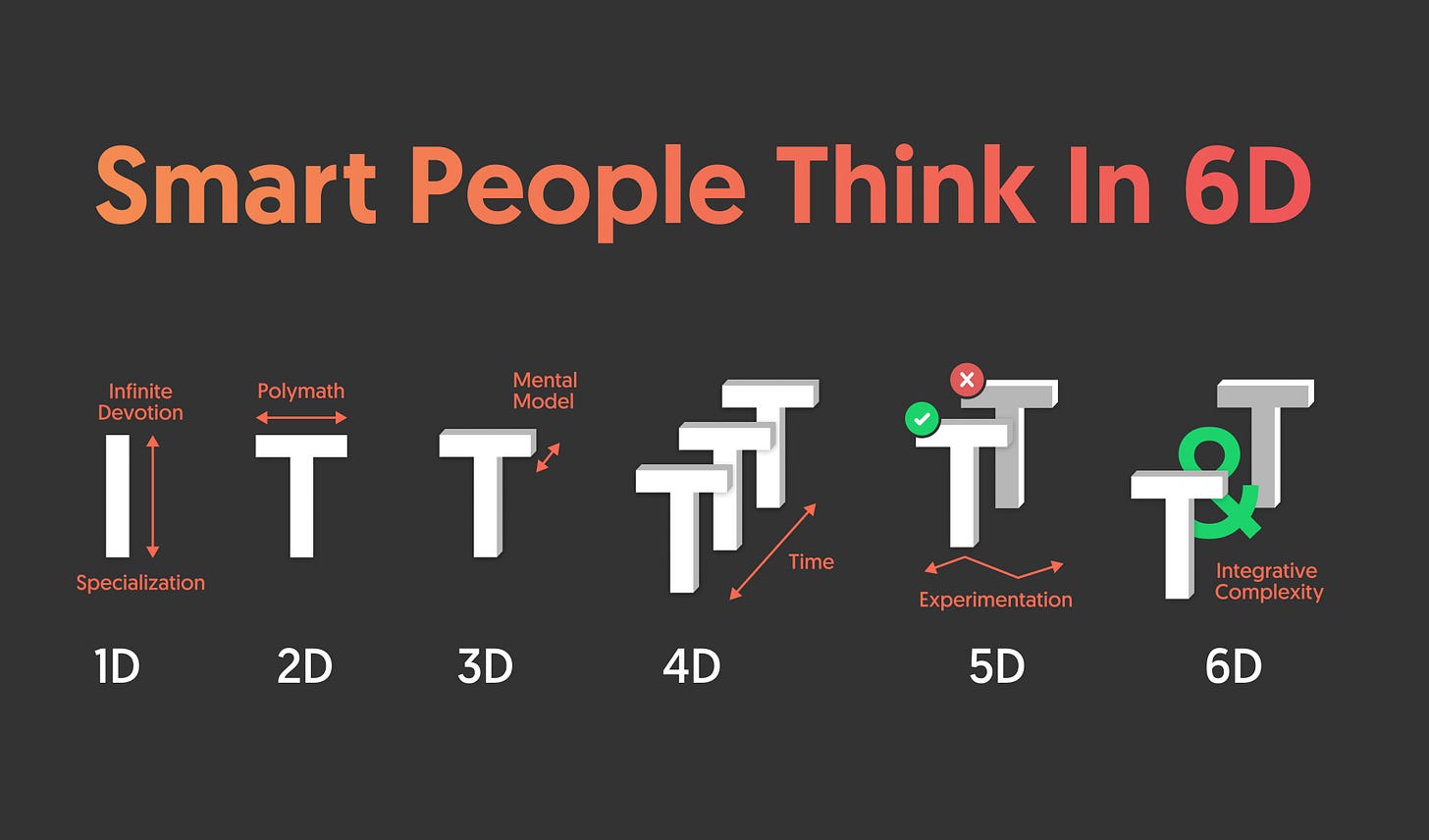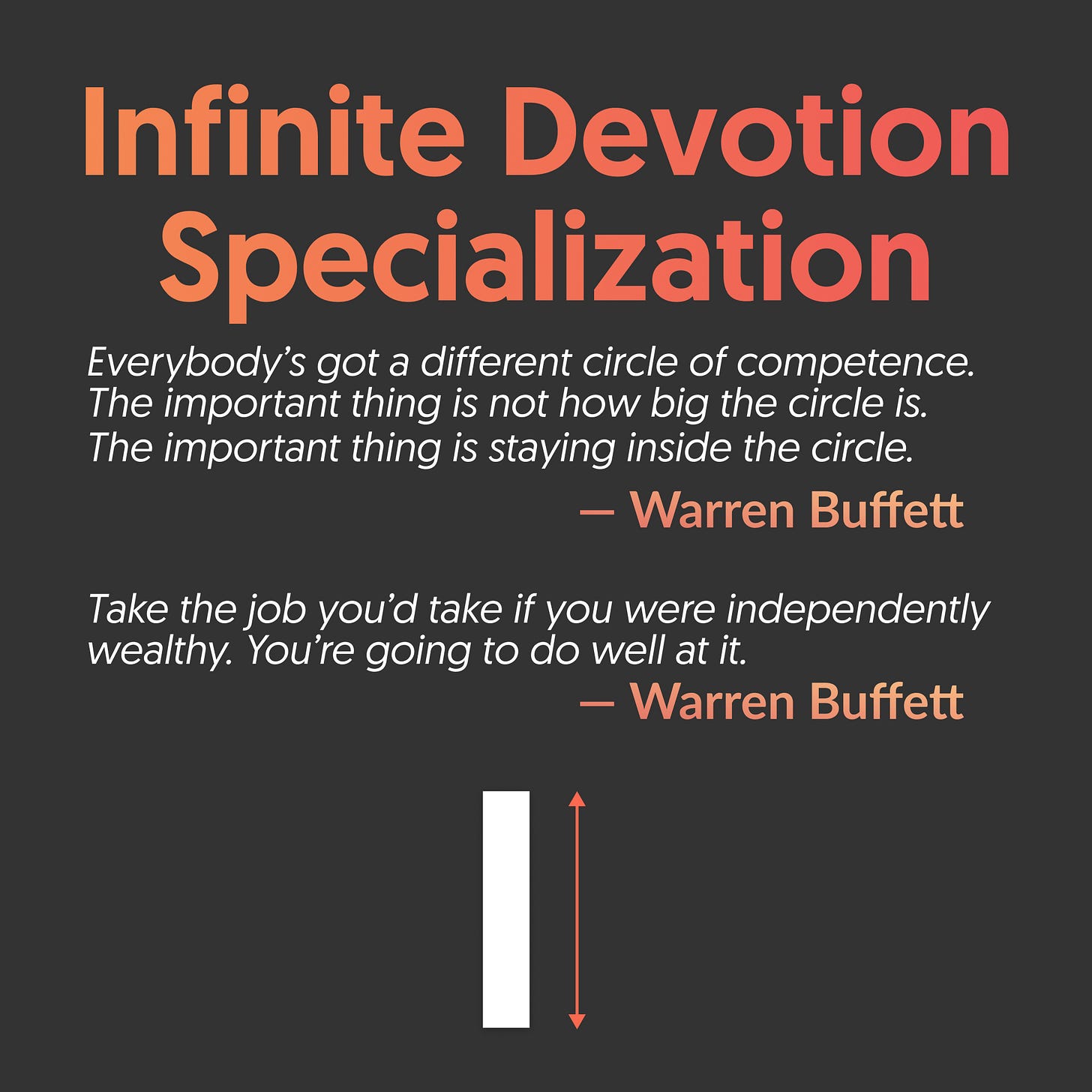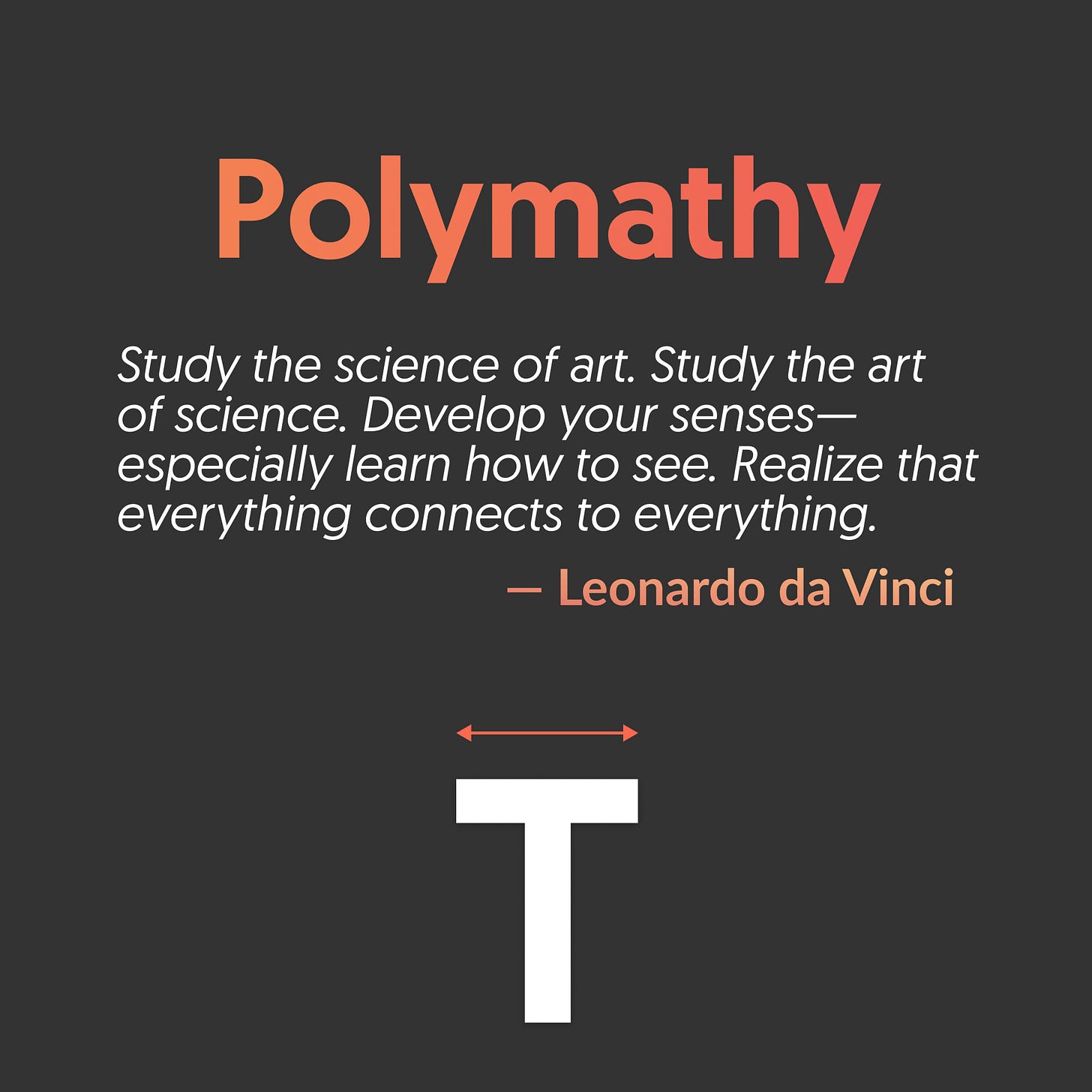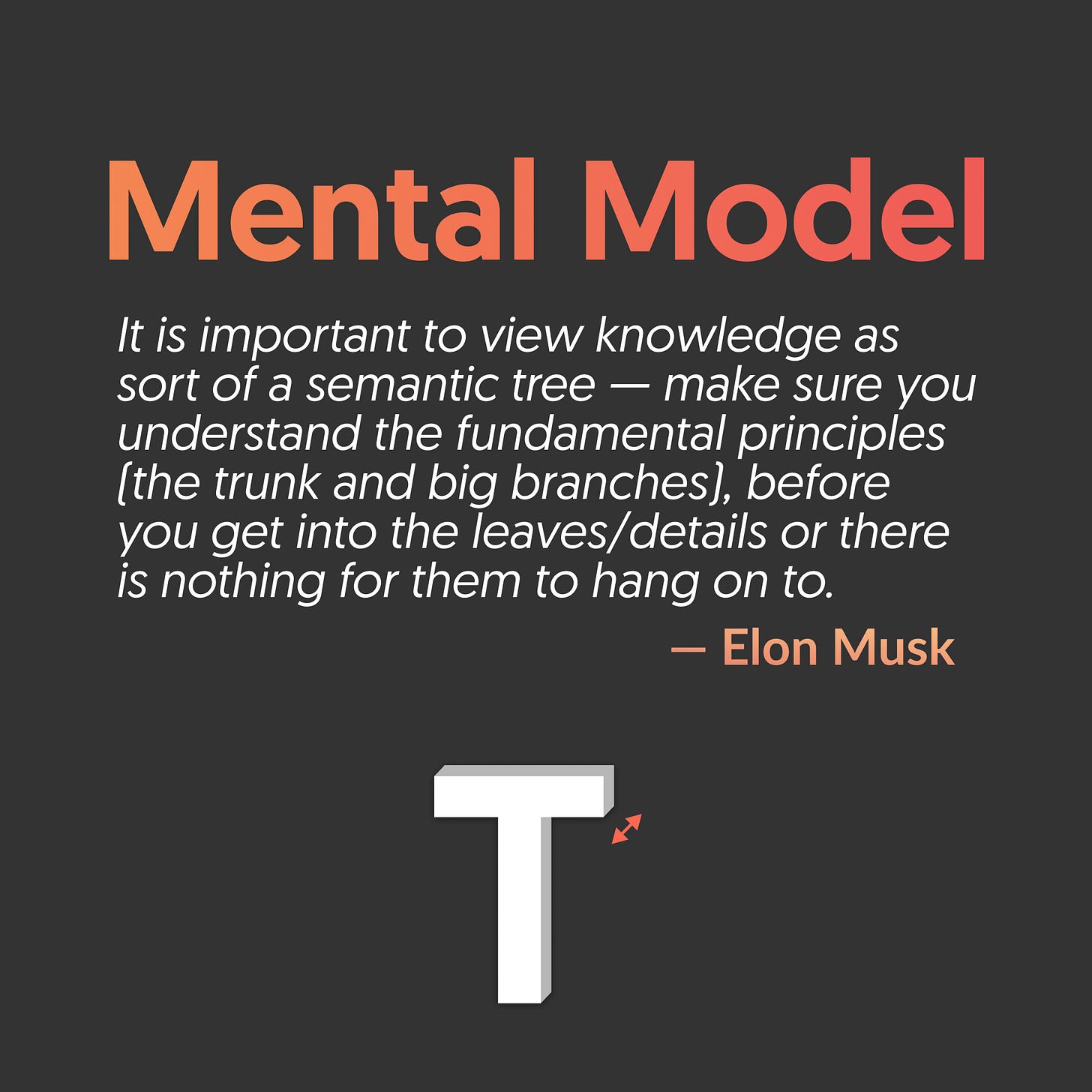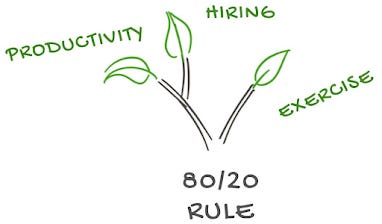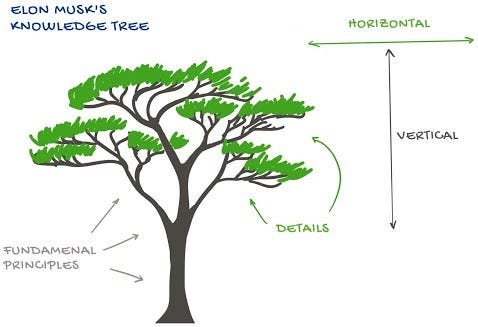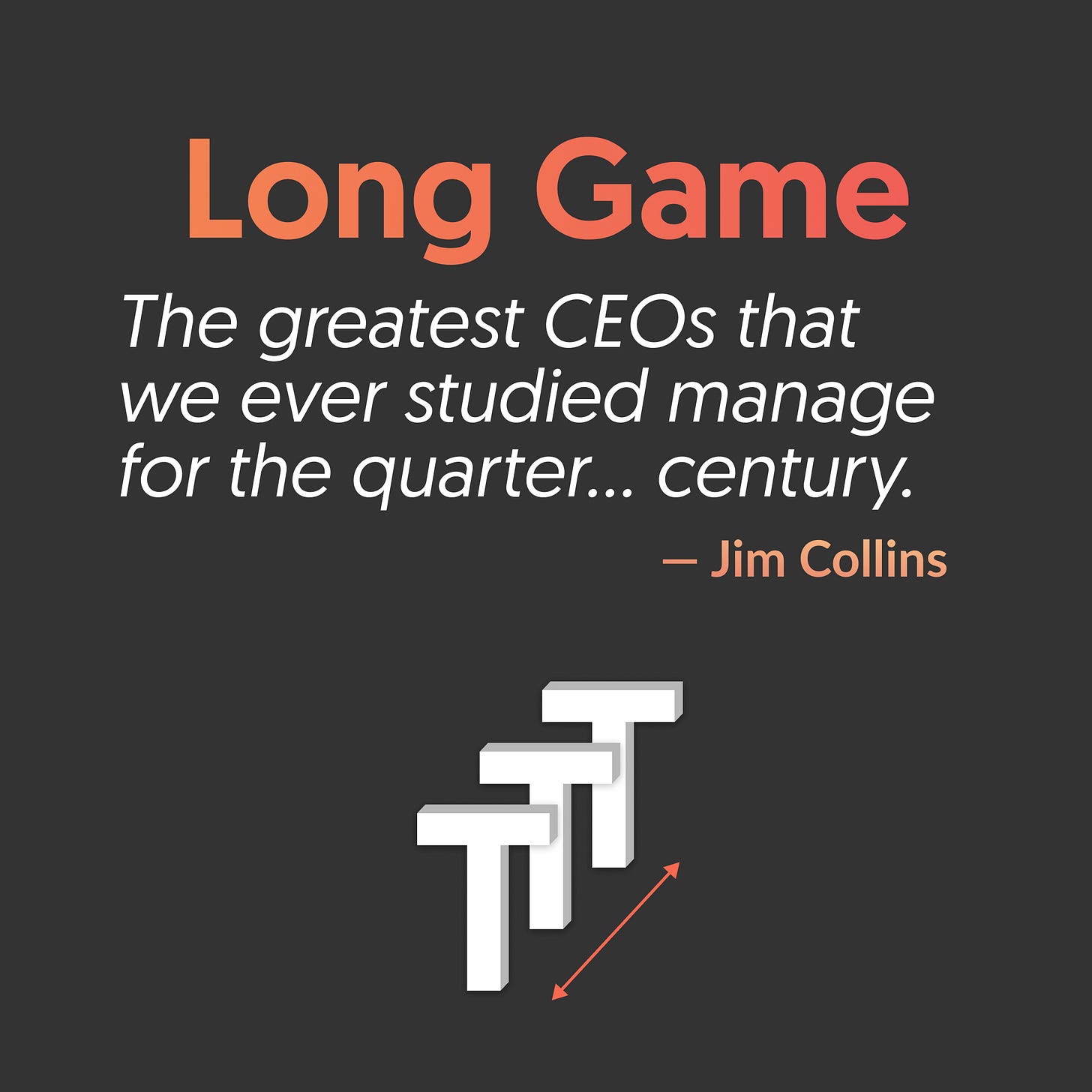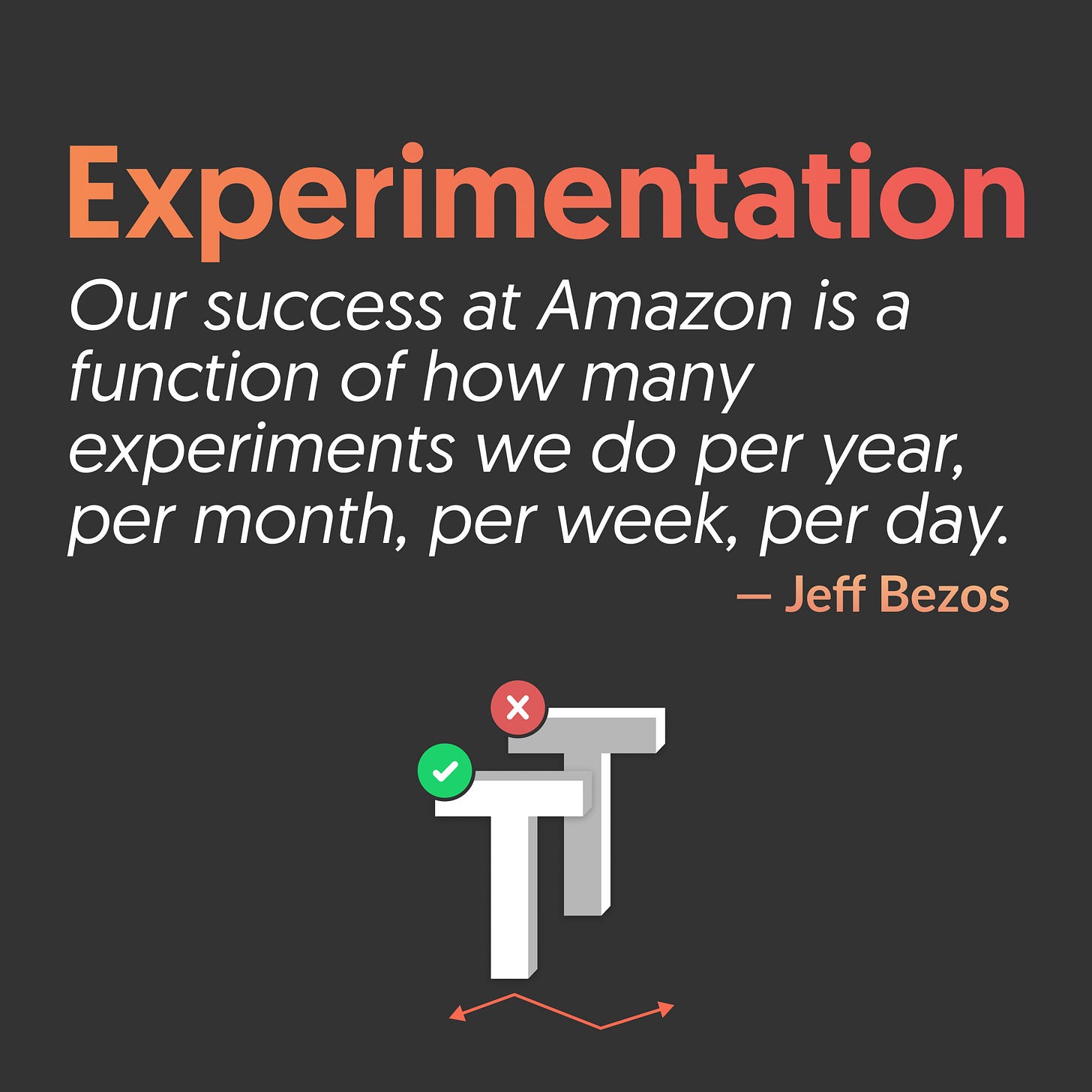6D Thinking: Bezos, Musk, & Buffett Learn Faster And Better Because They See Learning Differently
Over my last 8 years of writing about history’s most influential innovators and successful entrepreneurs (Thomas Edison, Elon Musk, Jeff Bezos, Ray Dalio, Warren Buffett, Frederick Taylor, Charlie Munger, Bill Gates) in addition to Nobel Laureates (Richard Feynman, Einstein, and others), I’ve realized that they don’t just work harder or do more productivity hacks. They actually inhabit a different paradigm of reality that’s hard to see.
The big clue is that many of their core work habits go completely against conventional wisdom…
They specialize in areas where they have Infinite Devotion
They learn across disciplines (polymathy)
They think using mental models (meta-thinking)
They play the long game (to the extreme)
They spend a surprising amount of time on experimentation and learning (rather than just working hard)
They think in opposing extremes (integrative complexity)
What’s surprising about this list is two-fold…
These individuals don’t just do unique things compared to others. Rather, what the average knowledge worker considers unproductive, innovative knowledge workers consider most productive.
Not only that, these extremely quirky individuals are quirky in similar ways.
I call these six similarities 6D thinking, and I’ll dive deep into each dimension in this article.
By becoming aware of and mastering these dimensions, your life will change. At least, that’s what happened to me.
Also, at the end of the article, I share a 90-minute on-demand recording of the masterclass I recently delivered on how to apply 6D thinking. It is for paid subscribers.
Let’s jump in…
Introducing 6D Thinking
6D thinking is the culmination of thousands of hours spent studying the most impactful investors, innovators, leaders, creatives, and scientists throughout history. Each dimension was like a revelation when I learned and wrote about it originally. But, only after years, did I start to see how they fit together into this larger, emergent structure.
Looking back, 6D thinking has had a profound impact on my life…
It boosted my creativity. By thinking in dimensions that others aren’t aware of, you’re able to create paradigm-changing ideas. Everyone says you need a unique point of view in order to stand out in today’s crowded world, but they don’t tell you how to do it. These six dimensions are the methodology.
It boosted my success. Each dimension helps you get a more accurate picture of reality. Take polymathy for example. Every field has figured out things and every field has blindspots. By learning across fields, you cancel out the blindspots and biases while adding to your knowledge base. Having a more accurate model of reality is key to success and legendary investor Ray Dalio poignantly explains why in this quote, “Truth - more precisely, an accurate understanding of reality - is the essential foundation for producing good outcomes.”
It boosted my enjoyment of life. Seeing reality from more and deeper perspectives isn’t just an intellectual exercise. It’s deeply moving. Now, I find that I am more often in states of wonder, curiosity, flow, and awe as a result of 6D thinking. As I experience these feelings more often and more deeply, they become more important to me. Now, I see the internal benefit of 6D thinking as the main benefit.
Below is more on each of the six dimensions along with links to articles I’ve written about them…
#1: Infinite Devotion Specialization
Great innovators don’t just specialize in an area where there is a market opportunity. They specialize in areas where they are so passionate they’d be willing to work more intensely and longer because they’re primarily pulled by the love of the game.
Below are specifics on how Infinite Devotion differs from conventional discipline:
What’s critical to understand is that Infinite Devotion is a quality that ALL iconic creators and performers have throughout history. Yet, many people sacrifice it in the name of being realistic and practical. Then, as a result of not having enough fire in the belly, they use discipline, goals, shame, and other conventional tools to force themselves to do things they don’t want to.
While everyone has to do things that are hard in order to succeed, with Infinite Devotion, the hard things feel less hard, and they even feel enjoyable. This is because they are held in a context of passion, curiosity, mastery, and meaning—all of which drastically boost intrinsic motivation.
Put differently, people who use discipline as their main motivation can become successful. But, people who use Infinite Devotion become even more successful and enjoy the journey. There is a similar dynamic in the field of entrepreneurship. The A students are top executives. The D students who self-educate are the owners.
READ MORE
So Passionate You Never Stop Improving: The Secret Behind the Success Of Asimov, Jobs, Seinfeld, Oprah, Buffett, Newton, And All The Greats.#2: Polymathy
The warning against being a generalist has persisted for hundreds of years in dozens of languages. “Equipped with knives all over, yet none is sharp,” warn people in China. In Estonia, it goes, “Nine trades, the tenth one—hunger.”
Yet, many of the most impactful individuals, both contemporary and historical, have been generalists: Elon Musk, Steve Jobs, Richard Feynman, Ben Franklin, Thomas Edison, Leonardo Da Vinci, and Marie Curie to name just a few.
What’s going on here?
If being a generalist was the path to mediocrity, why did the most comprehensive study of the most significant scientists in all of history uncover that 15 of the 20 were polymaths? Newton. Galileo. Aristotle. Kepler. Descartes. Huygens. Laplace. Faraday. Pasteur. Ptolemy. Hooke. Leibniz. Euler. Darwin. Maxwell—all polymaths.
If being a generalist was so ineffective, why are the founders of the five largest companies in the world—Bill Gates, Steve Jobs, Warren Buffett, Larry Page, and Jeff Bezos—all polymaths (who also follow the 5-hour rule)? Are these legends just genius anomalies? Or are they people we could and should imitate in order to be successful in a modern knowledge economy?
If being a generalist is an ineffective career path, why do 10+ academic studies find a correlation between the number of interests/competencies someone develops and their creative impact?
The answer is that being a modern polymath is one of the most powerful ways to have creative breakthroughs that change the world.
I define a modern polymath as someone who becomes competent in at least three diverse domains and integrates them into a top 1-percent skill set.
In other words, they bring the best of what humanity has discovered from across fields to help them be more effective in their core field. Hence the T-shape above. Specialists, on the other hand, just focus on knowledge from their own field, and they ignore all of the insights from all of the other fields that exist in the world.
And just as there have been quotes calling out the failure of generalists who never specialize, there have been unique names for Modern Polymaths throughout time calling out their success…
READ MORE
People Who Have "Too Many Interests" Are More Likely To Be Successful According To Research#3: Mental Models
Most people think on a surface level. They see different fields as siloed. This group, however, thinks on a deeper meta-level.
Here’s a visual way that shows the difference between thinking horizontally versus thinking horizontally and vertically…
When you think vertically and horizontally, suddenly fields that seemed disconnected appear connected. Here’s an example…
In the image below where the thinking is only horizontal, productivity, hiring, and exercising seem like completely unconnected fields.
In the image below, which is horizontal and vertical, these three fields are connected by a mental model—The 80/20 Rule:
20% of exercises create 80% of the results.
20% of employees create 80% of the value.
20% of productivity hacks create 80% of the value.
Since Musk has spent much time learning across fields and at a deeper level, his knowledge tree is huge…
Thanks to the size and complexity of his tree, Elon Musk can see exactly how different “leaves” and “branches” interact with each other. This gives him major superpowers:
He can reuse fundamental knowledge over and over.
He can take insights from one side of the tree to another.
He can identify small, high-leverage actions that can drastically improve the overall quality of everything he does.
Now, compare this to an average person who can only see one leaf at a time. This person:
Only uses their knowledge in the domain they learned it in, because they aren’t able to abstract it into a mental model that can be used everywhere.
Focuses on low-leverage hacks and band-aid solutions, because they miss deeper cause-effect dynamics that have 100x more more leverage.
READ MORE
The Secret "Thinking Tool” To Learn Faster, Make Better Decisions, Grow Your Business & Career, and Succeed In Life#4: Long Game
Where almost all public company CEOs, not to mention people in general, plan days, weeks, and months ahead, visionaries like Jeff Bezos and Elon Musk think decades or even centuries into the future. And they don’t just plan: They put their money where their mouths are. They make bold bets that won’t pay off anytime soon and that have a high probability of failure. In fact, I would say that these long-term thinkers redefine what it means to think long-term.
When I first came across this surprising observation, I wrote it off as a quirk. But as I’ve studied more of the world’s top entrepreneurs—taking an especially close look at Jeff Bezos—my opinion slowly shifted.
I now believe a long time horizon comes closer than any other factor to being a “magic bullet.”
Over the last several years, I’ve read hundreds of academic studies and books on scientifically validated approaches to being more successful and impactful and found that many factors correlate with success:
While each of these habits plays a part in adding to one’s overall impact, a long time horizon is essential for all of them.
If you’re thinking long-term, then:
The benefits of delayed gratification become obvious. You aren’t sacrificing the short term for an amorphous future. You’re sacrificing a much worse investment for a much better one. Over the period of a day, taking “time out” to reflect, exercise, learn, rest, build relationships, and experiment are distractions. Over the period of a lifetime, they are the best investments we can make.
Doing something that is extremely meaningful to you is absolutely critical. You can sustain a job, marriage, project, or company that bores or doesn’t inspire you for a short while, but not for a long time. A long time horizon goes hand in hand with purpose and passion. This purpose helps you work harder, learn harder (deliberate practice), create more (productive output), have more soul, and be willing to overcome challenges (resilience).
Not only yourself and your business are affected, but your relationships. Think of your most “successful” relationships. Chances are they evolved over a long time and constantly gave without expecting anything in return. A long time horizon is almost a prerequisite to defining a healthy, productive relationship in any realm.
READ MORE
Bezos, Musk, & Buffett See The World Differently, Because They See Time Differently#5: Experimentation
While most people focus on repeating what works, the innovators, scientists, and leaders I studied spend a surprisingly large amount of time learning the best of what humanity has figured out and then doing things that fail most of the time in order to find a few big winners (10,000 Experiment Rule).
To provide more context, perhaps the most popular current success formula is the 10,000-hour rule popularized by Malcolm Gladwell. The idea is that you need 10,000 hours of deliberate practice to become a world-class performer in any field.
Research now tells us, however, that this formula is woefully inadequate to explain success, especially in the professional realm. A 2014 review of 88 previous studies found that “deliberate practice explained 26% of the variance in performance for games, 21% for music, 18% for sports, 4% for education, and less than 1% for professions. We conclude that deliberate practice is important but not as important as has been argued.”
This chart summarizing the results should cause any ardent believer in the 10,000-hour rule to pause:

This means that deliberate practice may help you in fields that change slowly or not at all, such as music and sports. It helps you succeed when the future looks like the past, but it’s next to useless in areas that change rapidly, such as technology and business.
What great innovators teach us is that we should maximize the number of experiments, not hours. Instead of just the 10,000-hour rule, we also need what I call the 10,000-experiment rule.
Throughout history, the scientific method has arguably produced more human progress than any other philosophy. At the heart of the scientific method is experimentation: develop a hypothesis, perform a test to prove the hypothesis right or wrong, analyze the results, and create a new hypothesis based on what you learned. The 10,000-experiment rule takes this proven power of experimentation out of the lab and into day-to-day life.
Following the 10,000-experiment rule means starting your day with not just a to-do list but a“to-test” list like Leonardo Da Vinci. According to Walter Isaacson, one of Da Vinci’s biographers, “Every morning his life hack was: make a list of what he wants to know. Why do people yawn? What does the tongue of a woodpecker look like?”
As you go through your day, following the 10,000-experiment rule means constantly looking for opportunities to collect data rather than just doing what you need to do. It means adding a deliberate reflection process based on reviewing data before the day ends.
For example…
Do you want to improve your sales results by asking a new question at the end of sales calls? Now every sales call becomes an opportunity to ask that question and collect data so that you can learn how to make better sales calls in the future.
Do you want to sleep better so that you can have more energy during the day? You can research all the best practices for falling asleep, turn the most compelling ones into a routine, use a sleep tracker to get objective data on the quantity and quality of your sleep, and then make adjustments to your routine to improve the results.
To achieve 10,000 hours of deliberate practice requires three hours of deliberate practice per day for 10 years. I argue that the 10,000-experiment rule is just as difficult, yet doable, requiring three experiments per day.
READ MORE
Forget The 10,000-Hour Rule; Edison, Bezos, & Zuckerberg Follow The 10,000-Experiment Rule#6: Integrative Complexity
According to five fascinating studies performed by different researchers and different fields, one of the #1 under-appreciated skills of great leaders, innovators, and creatives is “integrative complexity.” This is the ability to develop opposing skills/mindsets/perspectives that are normally found in two different people. For example…
Being extremely confident and extremely humble
Being extremely visionary and extremely detail-oriented
Being extremely short-term and extremely long-term
What’s surprising about these five studies is that they’re independent and they come to the same conclusion and even use very similar language. For example…
Breakthrough Study 1: Self-Made Billionaire Entrepreneur Studied And Interviewed Some Of The Best Entrepreneurs Ever
In the first study, self-made billionaire Ray Dalio (author of Principles) conducted long interviews with and performed comprehensive personality assessments on Bill Gates, Steve Jobs, Elon Musk, Jeff Bezos, Reed Hastings (founder of Netflix), Muhammad Yunus (social entrepreneur and Nobel Peace Prize recipient), Jack Dorsey (Twitter co-founder and CEO), and other luminaries. To my knowledge, no other study has gone so in-depth with so many high-level, busy leaders.
After collecting the data, Dalio narrowed his findings into a list of seven common traits. Of those traits, Dalio said that the most interesting was this:
All are able to see both big pictures and granular details (and levels in between) and synthesize the perspectives they gain at those different levels, whereas most people see just one or the other. They are simultaneously creative, systematic, and practical. They are assertive and open-minded at the same time.
In an interview with Tony Robbins, Dalio further unpacks his observation:
They also tend to do things that you assume people don’t do together. Let me give you an example... Ordinarily, you’ll have a creative who you say, “Oh, they’re very, very creative but they don’t like structured.” Or a very structured person doesn’t like creativity…
The best ones are people who not only have good mental maps of how things should be done, but they have high levels of humility. [In other words, they are smart and humble.] It may not look that way to an outsider. You may look at some of these people and you might say, “Wow. They sound so brilliant and they’re asking the questions.” But if you’re in discussions with them, and I’m sure that you [Tony Robbins] have been in discussion with them, what you find out is generally speaking that they’re curious, voraciously curious. They’re wondering if they’re wrong. They’re taking in information. So they don’t look as confident when you’re in those conversations.
Breakthrough Study 2: Eminent Psychologist Studied Creative Geniuses
The second study was completed in 1996 by psychologist Mihaly Csikszentmihalyi (author of Flow), after performing in-depth interviews with a diverse group of 91 creative geniuses, from Nobel Laureates to business tycoons to renowned artists. When describing what these individuals had in common, he wrote this (it’s a long passage, but worth it):
If I had to express in one word what makes their personalities different from others, it would be complexity. By this I mean that they show tendencies of thought and action that in most people are segregated. They contain contradictory extremes — instead of being an ‘individual,’ each of them is a ‘multitude’…
These qualities are present in all of us, but usually we are trained to develop only one pole of the dialectic. We might grow up cultivating the aggressive, competitive side. A creative individual is more likely to be both aggressive and cooperative, either at the same time or at different times, depending on the situation. Having a complex personality means being able to express the full range of traits that are potentially present in the human repertoire but usually atrophy because we think that one or the other pole is ‘good,’ whereas the other extreme is ‘bad’…
A complex personality does not imply neutrality, or the average. It is not some position at the midpoint between two poles. It does not imply, for instance, being wishy-washy, so that one is never very competitive or very cooperative. Rather it involves the ability to move from one extreme to the other as the occasion requires.
Breakthrough Study 3: Leading Business Thinker Studied Business Icons
The third study was conducted by Roger Martin, who was named the world’s leading business thinker in 2017. Martin conducted in-depth interviews (some over eight hours long) with over 50 of the world’s top business leaders—such as Michael Dell, former Procter & Gamble CEO A.G. Lafley, and Jack Welch—and put his findings into several books. His conclusion echoes Csikszentmihalyi and Dalio:
What made them successful was not making trade-offs … just refusing, and then saying, ‘There’s got to be a better way.’
Martin calls this approach “integrative thinking,” and defines it in his book The Opposable Mind as:
The ability to face constructively the tension of opposing ideas and, instead of choosing one at the expense of the other, generate a creative resolution of the tension in the form of a new idea that contains elements of the opposing ideas but is superior to each.
Breakthrough Study 4: Adult Development Pioneer Surveyed Tens Of Thousands And Learned This
We also have the lifetime work of Harvard psychologist Robert Kegan and his peers in the field of adult development. To put their work in context, you should know that in the 1930s, psychologist Jean Piaget identified four universal stages of cognitive development in humans:
Piaget’s work suggested that adolescents reached a final stage, which they remained in throughout adulthood.
This understanding was later turned on its head by the adult development field, where longitudinal studies showed that similar to children, adults go through a series of universal and predictable phases as shown in the model below created by Robert Kegan…

The final stage of Kegan’s model, which only one percent of the population reaches, is called the Self-Transforming Mind. What’s fascinating about this stage is that one develops the ability to hold conflicting, contradictory, and paradoxical ideologies, thoughts, and values simultaneously. At this stage, we’re no longer a prisoner of one identity. Instead, we can fluidly explore the subtleties and complexities of multiple ways of experiencing reality. For a more complex overview, I recommend this 20-minute video of Kegan explaining his findings.
Breakthrough Study 5: Good To Great Author And Former Stanford Researcher Jim Collins Found That Great Leaders Follow The “Genius of the AND”
Collins explains…
Instead of being oppressed by the “Tyranny of the OR,” highly visionary companies liberate themselves with the “Genius of the AND”—the ability to embrace both extremes of a number of dimensions at the same time. Instead of choosing between A OR B, they figure out a way to have both A AND B.
We’re not talking about mere balance here. “Balance” implies going to the midpoint, fifty-fifty, half and half. A visionary company doesn’t seek balance between short-term and long-term, for example. It seeks to do very well in the short-term and very well in the long-term. A visionary company doesn’t simply balance between idealism and profitability; it seeks to be highly idealistic and highly profitable. A visionary company doesn’t simply balance between preserving a tightly held core ideology and stimulating vigorous change and movement; it does both to an extreme. In short, a highly visionary company doesn’t want to blend yin and yang into a gray, indistinguishable circle that is neither highly yin nor highly yang; it aims to be distinctly yin and distinctly yang — both at the same time, all the time.
Bottom line: Jim Collins studied top-performing companies. Robert Kegan studied highly developed adults. Roger Martin studied CEOs of major companies. Mihaly Csikszentmihalyi studied tycoons and creatives. Ray Dalio studied global change agents. Each came from a different field. Yet, they all came to a shockingly similar conclusion.
Top performers aim to understand the pros and cons of all perspectives and polarities and then synthesize them. This gives them a more accurate representation of reality and helps them see possibilities that people at the poles can’t. Unfortunately, culture seems to be going in the opposite direction as people retreat to tribalism and ideology rather than integration.
READ MORE
Studies Show That People Who Have High “Integrative Complexity” Are More Likely To Be Successful.Apply 6D Thinking To Your Life (Paid Subscribers)
To the uneducated mind, these six approaches seem quirky and inapplicable to the average person…
To the educated mind, these approaches are best practices in a paradigm that I call 6D thinking. The key is that you just need to know how to apply them.
In a recent 90-minute live class for our Mental Model Club, I broke down the 6D model in detail. As a paid subscriber of this newsletter, you can access the on-demand version…


